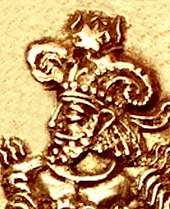Peroz (Kidarite)
Peroz (Middle Persian: 𐭯𐭩𐭫𐭥𐭰, Gupta script: ![]()
![]()
![]()
| Peroz | |
|---|---|
._Circa_350-375_CE.jpg) The name "Peroz" (Pi-ro-ysa) appears on the coins of "Gadahara" (for the region of Gandhara), thought to belong to the Kidarite Huns. On the obverse, vertically: Right field: The name Middle field: This issue has the name Piroysa ( Left field: | |
| Kidarites | |
| Reign | circa 350-360 CE |
| Predecessor | Kirada |
| Successor | Kidara |
Rule
The rule of the Kushano-Sasanians ended in the mid-4th century CE,[7] when they lost their territories to the invading Kidarites Huns.[8]
Peroz was a successor of the first Kidarite ruler Kirada, and the immediate predecessor of the famous Kidarite ruler Kidara.[4][5][6] He was previously thought to be one of the last of the Kushano-Sasanids Kushanshas rulers.[9]
He minted his own coinage and used the title of Kushansha, ie "Kings of the Kushans".[10]
Siege of Amida (359 CE)
Historian Khodadad Rezakhani suggests that Peroz was at the Siege of Amida in 359 CE, where a Kidarite army under Grumbates is known to have supported the Sasanian army of Shapur II in besieging the city held by the Romans.[11] In his account of the siege, Ammianus Marcellinus describes in detail the costume, and in particular the headgear of one of the besieging rulers:[11]

The king himself, mounted upon a charger and overtopping the others, rode before the whole army, wearing in place of a diadem a golden image of a ram’s head set with precious stones, disinguished too by a great retinue of men of the highest rank and of various nations.
— Ammianus, Roman Antiquities, 1935:471[11]
This ruler is traditionally held to be Shapur II, although Ammanus Marcellinus doesn't expressly say so, and Shapur's traditional headgear, a crenellated crown, is very different.[11] The headgear with ram's horn would rather correspond to that of Peroz as seen on many of his coins in the Sasanian style.[11] Ammianus Marcellinus also mentions that the king, whom he assumes to be Shapur, was called "Saansaan" and "Pirosen" by the Persians, which could actually refer to "Šāhanšāh Pērōz", the ruler of the eastern Hunnic tribes (Chionites, Gelani, and Sagistani).[12]
Coinage in the style of the Kushano-Sasanians
Besides his coins in the Kushan style, Peroz issues silver and gold coinage in the Sasanian style, in which he often retains the name of Kushano-Sasanian ruler Varahran I, but in which Varahran is shown wearing a characteristic Sasanian headgear with the addition of two ram horns.[11][13]


_I_struck_under_Kidarite_ruler_Peroz_Circa_AD_330_365_CE.jpg) Coin in the name of the Kushano-Sasanian ruler Varahran I, struck under Peroz (ram horns added), circa AD 330 365 CE. Kidarite tamgha
Coin in the name of the Kushano-Sasanian ruler Varahran I, struck under Peroz (ram horns added), circa AD 330 365 CE. Kidarite tamgha
References
- Tandon, Pankaj (2009). "The Western Kshatrapa Dāmazāda". The Numismatic Chronicle. 169: 177. JSTOR 42678610.
- A Comprehensive History of India. Orient Longmans. 1957. p. 253.
- Tandon, Pankaj (2009). "The Western Kshatrapa Dāmazāda". The Numismatic Chronicle. 169: 177. JSTOR 42678610.
- Rezakhani, Khodadad (2017). ReOrienting the Sasanians: East Iran in Late Antiquity. Edinburgh University Press. p. 85. ISBN 9781474400305.
- Cribb, Joe (2018). Problems of Chronology in Gandhāran Art: Proceedings of the First International Workshop of the Gandhāra Connections Project, University of Oxford, 23rd-24th March, 2017. The Classical Art Research Centre University of Oxford Archaeopress. p. 23.
- Cribb, Joe. "The Kidarites, the numismatic evidence.pdf". Coins, Art and Chronology II, Edited by M. Alram et Al.
- The Cambridge History of Iran, Volume 3, E. Yarshater p.209 ff
- The Cambridge Companion to the Age of Attila, Michael Maas, Cambridge University Press, 2014 p.284 ff
- Silk Road Art and Archaeology: Journal of the Institute of Silk Road Studies, Kamakura. The Institute. 2001. p. 179.
- The Cambridge History of Iran, Volume 3, E. Yarshater p.209 sq
- Rezakhani, Khodadad (2017). "Saansaan Pirosen: Ammianus Marcellinus and the Kidarites". The Digital Archive of Brief Notes & Iran Review, University of California. 1 (3): 44–50.
- “Persis Saporem saansaan appellantibus et pirosen, quod rex regibus imperans et bellorum victor interpretatur.” (Amm. Marc. XIX.2.11) “The Persians called Sapor “Saansaan” and “pirosen,” whish being interpreted is “king of kings” and “victor in wars.” (Ammianus, Roman Antiquities, 1935: 481) in Rezakhani, Khodadad (2017). "Saansaan Pirosen: Ammianus Marcellinus and the Kidarites". The Digital Archive of Brief Notes & Iran Review, University of California. 1 (3): 44–50.
- Cribb, Joe (2018). Problems of Chronology in Gandhāran Art: Proceedings of the First International Workshop of the Gandhāra Connections Project, University of Oxford, 23rd-24th March, 2017. Archaeopress. p. 27. ISBN 9781784918552.
- CNG Coins
- CNG Coins
- Another similar coin with reading
Sources
- Daryaee, Touraj; Rezakhani, Khodadad (2017). "The Sasanian Empire". In Daryaee, Touraj (ed.). King of the Seven Climes: A History of the Ancient Iranian World (3000 BCE - 651 CE). UCI Jordan Center for Persian Studies. pp. 1–236. ISBN 9780692864401.CS1 maint: ref=harv (link)
- Kia, Mehrdad (2016). The Persian Empire: A Historical Encyclopedia [2 volumes]: A Historical Encyclopedia. ABC-CLIO. ISBN 978-1610693912.CS1 maint: ref=harv (link)
- Rapp, Stephen H. (2014). The Sasanian World through Georgian Eyes: Caucasia and the Iranian Commonwealth in Late Antique Georgian Literature. Ashgate Publishing, Ltd. ISBN 978-1472425522.CS1 maint: ref=harv (link)
- Payne, Richard (2016). "The Making of Turan: The Fall and Transformation of the Iranian East in Late Antiquity". Journal of Late Antiquity. Johns Hopkins University Press. 9: 4–41. doi:10.1353/jla.2016.0011.CS1 maint: ref=harv (link)
- Rezakhani, Khodadad (2017). "East Iran in Late Antiquity". ReOrienting the Sasanians: East Iran in Late Antiquity. Edinburgh University Press. pp. 1–256. ISBN 9781474400305. JSTOR 10.3366/j.ctt1g04zr8.CS1 maint: ref=harv (link) (registration required)
- Vaissière, Étienne de La (2016). "Kushanshahs i. History". Encyclopaedia Iranica.CS1 maint: ref=harv (link)
| Preceded by Kirada |
Kidarites 350-360 |
Succeeded by Kidara |